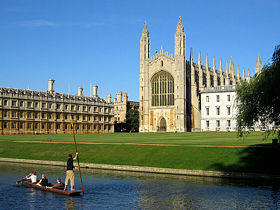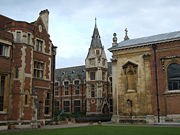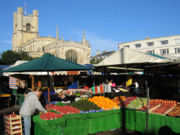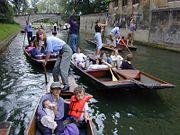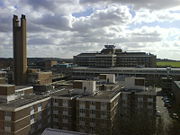Cambridge
2008/9 Schools Wikipedia Selection. Related subjects: British Cities; Great Britain
| City of Cambridge | |||
| King's College Chapel, seen from The Backs | |||
|
|||
| Cambridge shown within Cambridgeshire | |||
| Coordinates: | |||
|---|---|---|---|
| Sovereign state | United Kingdom | ||
| Constituent country | England | ||
| Region | East of England | ||
| Ceremonial county | Cambridgeshire | ||
| Admin HQ | Cambridge City Centre | ||
| Founded | 1st century | ||
| City status | 1951 | ||
| Government | |||
| - Type | Shire district, City | ||
| - Governing body | Cambridge City Council | ||
| - Mayor | Mike Dixon | ||
| - MPs: | David Howarth (LD) Andrew Lansley (C) |
||
| Area | |||
| - District & City | 44.7 sq mi (115.65 km²) | ||
| Population (2006 est.) | |||
| - District & City | 117,900 ( Ranked 171st) | ||
| - Urban | 130,000 (est.) ( Cambridge Urban Area) |
||
| - County | 752,900 | ||
| - Ethnicity |
74.5% White British 1.4% White Irish 9.6% White Other 2.2% Mixed Race 5.2% British Asian 5.0% Chinese and other 2.2% Black British |
||
| Time zone | Greenwich Mean Time ( UTC+0) | ||
| Postcode | CB | ||
| Area code(s) | 01223 | ||
| Website: www.cambridge.gov.uk | |||
The city of Cambridge ( pronunciation Came-bridge) is a university town and the administrative centre of the county of Cambridgeshire, England. It lies about 50 miles (80 km) north of London and is surrounded by a number of smaller towns and villages. It is also at the heart of the high-technology centre known as Silicon Fen.
Cambridge is best known for the University of Cambridge, which includes the renowned Cavendish Laboratory, King's College Chapel, and the Cambridge University Library. The Cambridge skyline is dominated by the last two buildings, along with the chimney of Addenbrooke's Hospital in the far south of the city and St John's College Chapel tower in the north. The city's name is pronounced /ˈkeɪmbrɪdʒ/, as opposed to another Cambridge in Gloucestershire, England, which is pronounced /ˈkæmbrɪdʒ/.
According to the 2001 United Kingdom census, the City's population was 108,863 (including 22,153 students), and the population of the urban area (which includes parts of South Cambridgeshire district) is estimated to be 130,000.
History
Prehistory
Settlements have existed around this area of East Anglia since before the Roman Empire. The earliest clear evidence of occupation, a collection of hunting weapons, is from the Late Bronze Age, starting around 1000 BC. There is further archaeological evidence through the Iron Age, a Belgic tribe having settled on Castle Hill in the 1st century BC.
Roman times
The first major development of the area began with the Roman invasion of Britain in about AD 40. Castle Hill made Cambridge a useful place for a military outpost from which to defend the River Cam. It was also the crossing point for the Via Devana which linked Colchester in Essex with the garrisons at Lincoln and the north. This Roman settlement has been identified as Duroliponte.
The settlement remained a regional centre during the 350 years after the Roman occupation, until about AD 400. Roman roads and walled enclosures can still be seen in the area.
Saxon and Viking age
After the Romans had left, Saxons took over the land on and around Castle Hill. Their grave goods have been found in the area. During Anglo-Saxon times Cambridge benefited from good trade links across the otherwise hard-to-travel fenlands. By the 7th century, however, visitors from nearby Ely reported that Cambridge had declined severely. Cambridge is mentioned in the Anglo-Saxon Chronicle as Grantebrycge.
The arrival of the Vikings in Cambridge was recorded in the Anglo-Saxon Chronicle in 875. Viking rule, the Danelaw, had been imposed by 878. The Vikings' vigorous trading habits caused Cambridge to grow rapidly. During this period the centre of the town shifted from Castle Hill on the left bank of the river to the area now known as the Quayside on the right bank. After the end of the Viking period the Saxons enjoyed a brief return to power, building St Bene't's church in 1025, which still stands in Bene't Street.
Norman times
In 1068, two years after his conquest of England, William of Normandy built a castle on Castle Hill. Like the rest of the new kingdom, Cambridge fell under the control of the King and his deputies. The distinctive Round Church dates from this period. By Norman times the name of the town had mutated to Grentabrige or Cantebrigge (Grantbridge), while the river that flowed through it was called the Granta.
Over time the name of the town changed to Cambridge, while the river Cam was still known as the Granta — indeed the Upper River (the stretch between the Millpond in Cambridge and Grantchester) is correctly known as the Granta to this day. The Welsh language name of the town remains Caergrawnt (roughly analogous to Grantchester, which is also the name of a village near Cambridge). It was only later that the river became known as the Cam, by analogy with the name Cambridge. The University, formed 1209, uses a Latin adjective cantabrigiensis (often contracted to "Cantab") to mean "of Cambridge", but this is obviously a back-formation from the English name.
Beginnings of the university
In 1209, students escaping from hostile townspeople in Oxford fled to Cambridge and formed a university there. The oldest college that still exists, Peterhouse, was founded in 1284. One of the most impressive buildings in Cambridge, King's College Chapel, was begun in 1446 by King Henry VI. The project was completed in 1515 during the reign of King Henry VIII.
Cambridge University Press originated with a printing licence issued in 1534. Hobson's Conduit, the first project to bring clean drinking water to the town centre, was built in 1610 (by the Hobson of Hobson's choice). Parts of it survive today. Addenbrooke's Hospital was founded in 1766. The railway and station were built in 1845. According to legend, the University dictated their location: well away from the centre of town, so that the possibility of quick access to London would not distract students from their work. However, there is no basis for this in written record.
Despite having a university, Cambridge was not granted its city charter until 1951. Cambridge does not have a cathedral (traditionally a pre-requisite for city status), and falls within the Church of England Diocese of Ely.
Original historical documents relating to the town of Cambridge (as opposed to the university or colleges within Cambridge) are held by Cambridgeshire Archives and Local Studies at the County Record Office Cambridge and at the Cambridgeshire Collection. These records include original registers for the parish churches dating back to the 1530s, local government records, maps, photographs, and records of some businesses, schools and charities.
Cambridge today
Cambridge is now one of East Anglia's major settlements, along with Norwich, Ipswich and Peterborough. Throughout the 1960s and 1970s, the size of the city was greatly increased by several large council estates planned to hold London's overspill. The biggest impact has been on the area north of the river, which is now home to the estates of Arbury, East Chesterton and King's Hedges, while there are many smaller estates to the south of the city.
Drawing on its links with the University, the Cambridge area today is sometimes referred to as Silicon Fen, due to the growth of high tech businesses and technology incubators that have sprung up in the series of science parks and other developments in and around the city. Such companies include CSR, world leader in Bluetooth chips, Acorn Computers (now ARM) and Sinclair. Cambridge was also the home of Pye Limited famous in the last century for early wireless and TV sets. In later years Pye evolved into several other companies including Pye Telecommunications (now Sepura, famous for TETRA radio equipment). Another major business is Marshall Aerospace located on the eastern edge of the city. Such businesses and their early stage precursors are well networked within the Cambridge Network.
The University was joined by the larger part of Anglia Ruskin University, and the educational reputation has led to other bodies (such as the Open University in East Anglia) basing themselves in the city.
Governance
Local government
Cambridge is a non-metropolitan district served by a city council. The city council's headquarters are in the Guildhall , an imposing building in the market square. Cambridge is also served by Cambridgeshire County Council.
For electoral purposes the city is divided into the following wards: Abbey, Arbury, Castle, Cherry Hinton, Coleridge, East Chesterton, King's Hedges, Market, Newnham, Petersfield, Queen Edith's, Romsey, Trumpington and West Chesterton.
The political composition of the city wards of the county council after the May 2005 elections was:
- 10 Liberal Democrat seats
- 4 Labour seats
The political composition of the city council after the May 2008 elections was:
- 28 Liberal Democrat councillors
- 11 Labour councillors
- 1 Green councillor
- 1 Conservative councillor
- 1 Independent councillor
The Liberal Democrats have controlled the city council since 2000.
Westminster
The parliamentary constituency of Cambridge covers most of the city. David Howarth (Liberal Democrat) was elected Member of Parliament (MP) at the 2005 general election, winning the seat from the sitting MP, Labour's Anne Campbell. Some areas, however — corresponding largely to the Queen Edith's and Trumpington wards — lie in the South Cambridgeshire constituency, whose MP is Andrew Lansley (Conservative), first elected in 1997. The city had previously elected a Labour MP from 1992 to 2005 and prior to this, usually elected a Conservative after the Second World War. However, the Conservatives came third in the last General Election and have seen their share of the vote fall over the past 20 years.
The University used to have a seat in the House of Commons, Sir Isaac Newton being one of the most notable holders. The Cambridge University constituency was abolished under 1948 legislation, and ceased at the dissolution of Parliament for the 1950 general election, along with the other university constituencies.
Districts
In 2001 are inside the inner ring road was divided into eight areas, called Kite, Regent, Downing, Queens, Jesus, Quayside, Brunswick and Fitzroy. Some of these names refer to areas that have long been known under that name (E.g. Kite).
Transport
Roads
Because of its rapid growth since the twentieth century, Cambridge has a congested road network. Several major roads intersect at Cambridge. The M11 motorway from east London terminates here. The A14 (formerly A604 and A45) east–west trunk route skirts the northern edge of the city. This is a major freight route connecting the port of Felixstowe on the east coast with the Midlands, North Wales, the west coast and Ireland. The A14 is often congested, particularly the section between Huntingdon and Cambridge where the east–west traffic is merged with the A1 to M11 north–south traffic on a 2-lane dual carriageway. The A10, a former Roman road from north London, passes round the city on its way to Ely and King's Lynn. Other roads connect the city with Bedford, St Neots, Newmarket and Colchester.
The city has a ring road about 2 km in diameter, inside which there are traffic restrictions which have successfully improved conditions for pedestrians, cyclists and bus users, and reduced congestion. It has a well developed bus service including five Park and Ride sites encouraging motorists to park near the city's edge.
Rail
Cambridge railway station was built in 1845 with a platform designed to take two full-length trains, one of the longest in the country. Cambridge has direct rail links to King's Cross (via Hitchin and the East Coast Main Line) and Liverpool Street (via the West Anglia Main Line) stations in London. There is a direct shuttle service to London King's Cross every half hour during off peak hours, taking only 45 minutes to reach London. Peak hour trains to Kings Cross all have additional stops, and take between 55 and 65 minutes. It is also linked to King's Lynn and Ely (via the Fen Line), Norwich (via the Breckland Line), Leicester, Birmingham, Ipswich and as well as London Stansted Airport. The important UK rail hub of Peterborough is also within reach of Cambridge. The railway service connecting Cambridge and Oxford, known as the Varsity Line, was discontinued in 1968.
Air
Cambridge City Airport is owned by Marshall Aerospace. The runway can accommodate an unladen Boeing 747 or MD-11, but there is no regular scheduled service, though ScotAirways used to make scheduled flights to Amsterdam Schiphol Airport, and it is mostly used by business and leisure flights. In 2004 a charter service to Jersey was operated by Aurigny Air Services using Saab 340 turboprop aircraft. A dealer in fibreglass-moulded light monoplanes is also based here. Removal of Marshalls to a site away from the city, with development of the airport site for housing, is a possibility over the next 5-10 years.
The London airports at Luton and Stansted, are both within 30 miles (50 km) of Cambridge.
Cycling
As a university town lying on fairly flat ground and with traffic congestion, Cambridge has a large number of cyclists. Many residents also prefer cycling to driving in the narrow, busy streets, giving the city the highest level of cycle use in the UK. According to the 2001 census, 25% of residents travelled to work by cycle. A few roads within the city are adapted for cycling, including separate traffic lights for cycle lanes and cycle contraflows on streets which are otherwise one-way; the city also benefits from parks which have shared use paths. There are, however, no separate cycle paths within the city centre. Despite the high levels of cycling, expenditure on cycling infrastructure is around the national average of 0.3% of the transport budget. There are a few cycle routes in the surrounding countryside and the city is now linked to the National Cycle Network. The main organisation campaigning to improve conditions for cyclists in Cambridge is the Cambridge Cycling Campaign.
Bike theft in the city is a problem, with over 3000 bicycles reported stolen between April 2005 and March 2006. The actual number is believed to be higher as many thefts are not reported to the police.
Park and ride
There are five park and ride sites in Cambridge, three of which (in Trumpington, Madingley Road and Newmarket Road) operate 7 days a week.
Guided bus
Cambridgeshire Guided Busway, set to be the world's longest guided busway, is under construction and will pass through Cambridge. It will run on the road from Huntingdon to St Ives, then along a disused railway line to north Cambridge, where it rejoins the road, to the city's railway station from where it will be guided to Addenbrooke's Hospital and Trumpington. The scheme is budgeted at £116.2 million is scheduled to open in early 2009. The scheme has been heavily criticised by campaigners who believe that the route would be better served by a rail link.
Sport
Football
Cambridge played a unique role in the invention of modern football as the game's first set of rules were drawn up by members of the university in 1848. The Cambridge Rules were first played in Parker's Piece and had a "defining influence on the 1863 Football Association rules.".
The city is home to Cambridge United F.C., who played in the Football League at the Abbey Stadium from 1970 to 2005, when they were relegated to Conference National. When relegation became inevitable the club was placed in administration with substantial debts, but it emerged from administration in time for the 2005–06 season. The club's biggest success came in the early 1990s, with two successive promotions, two successive FA Cup quarter-final appearances, a run to the Football League Cup quarter-finals, and reaching the brink of promotion to the new Premier League.
The city's other football club Cambridge City F.C. play in the Southern Football League Premier Division at the City Ground in Chesterton. Histon, just north of Cambridge, is home to Conference National side Histon.
Rugby
Cambridge's most successful sports team over recent years is its rugby union club. After three successive promotions they managed to survive their debut season in National Division Two 2006/07. The club's home ground is at West Renault Park on Granchester Road in the south west corner of the city. Cambridge Eagles rugby league team play in the National Conference League East Section during the summer months, often drawing on rugby union players keen to continue playing rugby throughout the year.
Other sports
As well as being the home of the Cambridge Rules, Parker's Piece played an important part in the playing career of W. G. Grace. Cambridge is also home to two Real Tennis courts out of just 42 in the world at Cambridge University Real Tennis Club. British American Football League club Cambridgeshire Cats play at Coldham's Common.
Motorcycle speedway racing took place at the Greyhound Stadium in Newmarket Road in 1939. It is not known if this venue operated in other years. The team raced as Newmarket as the meetings were organised by the Newmarket Motorcycle Club.
The City Council hosts details of Local Sports Clubs.
Varsity sports
Cambridge is also known for its university sporting events against Oxford, especially the rugby union Varsity Match and the Boat Race. These are followed by people across the globe, many of whom have no connection to the institutions themselves.
Health
Cambridge is well served by medical care, with several smaller medical centres dotted around the city, along with Addenbrooke's Hospital a learning and teaching hospital and one of the largest in the United Kingdom, also functioning as a centre for medical research.
Population
In the 2001 Census (held during University term), 89.44% of Cambridge residents identified themselves as white, compared with a national average of 92.12%. Within the University, 84% of undergraduates and 80% of post-graduates identify as white (including overseas students).
Cambridge has a much higher than average proportion of people in the highest paid professional, managerial or administrative jobs (32.6% vs. 23.5%) and a much lower than average proportion of manual workers (27.6% vs. 40.2%). In addition, a much higher than average proportion of people have a high level qualification (e.g. degree, HND, qualified doctor), (41.2% vs. 19.9%).
Historical population
| Historical population of Cambridge | ||||||||||
| Year | 1801 | 1811 | 1821 | 1831 | 1841 | 1851 | 1861 | 1871 | 1881 | 1891 |
|---|---|---|---|---|---|---|---|---|---|---|
| Population | 10,087 | 11,108 | 14,142 | 20,917 | 24,453 | 27,815 | 26,361 | 30,078 | 35,363 | 36,983 |
| Year | 1901 | 1911 | 1921 | 1931 | 1951 | 1961 | 1971 | 1981 | 1991 | 2001 |
| Population | 38,379 | 40,027 | 59,264 | 66,789 | 81,500 | 95,527 | 99,168 | 87,209 | 107,496 | 108,863 |
|
Census: Regional District 1801-1901 Civil Parish 1911-1961 District 1971-2001 |
||||||||||
Religion
Cambridge has an active Christian population and many churches, some of which form a significant part of the city's architectural landscape.
A Cambridge-based family and youth organisation, Romsey Mill, had its centre re-dedicated in 2007 by the Archbishop of York, and is quoted as an example of best practice in a study into social inclusion by the East of England Regional Assembly.
Cambridge falls into the Roman Catholic Diocese of East Anglia.
University
Great St Mary's Church has the status of being the "University Church". Many of the University colleges contain chapels that hold services according to the rites and ceremonies of the Church of England, while the chapel of St Edmund's College is Roman Catholic. There is a mosque used by Muslim residents and students, an Orthodox synagogue (belonging to the university Jewish Society) and the Beth Shalom Reform synagogue.
The city also has a number of theological colleges for training clergy for ordination into a number of denominations, with affiliations to both the University of Cambridge and Anglia Ruskin University.
Theatre
Cambridge's main theatre is the Arts Theatre, a venue with 666 seats in the town centre. The theatre often has touring shows, as well as those by local companies. Cambridge Arts Theatre Website
There are many amateur theatre groups in Cambridge, often producing plays of a very high standard. The ADC Theatre is managed by the University of Cambridge, and typically has 3 shows a week during term time. The Mumford Theatre is part of Anglia Ruskin University, and hosts shows by both student and non student groups. There are also a number of venues within the colleges. Camdram.net
Cambridge in fiction
- Gwen Raverat, the granddaughter of Charles Darwin, talked about her late Victorian Cambridge childhood in her memoir Period Piece - The Cambridge Childhood. She discusses mundane happenings from her life and those of her eccentric family through beautiful prose and line drawings. A picture into a bygone era and Cambridge academic society.
- In the 1950s, the English children's writer Philippa Pearce created a fictionalised version of Cambridge known as "Castleford" (not connected to the real town of the same name in West Yorkshire). It appears in several of her books, most notably Tom's Midnight Garden and Minnow on the Say. The main distinguishing point between "Castleford" and the real Cambridge is that this "Castleford" does not have a university.
- Tom Sharpe is also a Cambridge-based author who has written fictional accounts of teaching at Cambridge Technical College (now Anglia Ruskin University) and of Cambridge college life. His fictional "Porterhouse College" appears in many of his novels.
- Susanna Gregory wrote a series of novels set in 14th century Cambridge and featuring a teacher of medicine and sleuth named Matthew Bartholomew.
- Douglas Adams was at one time a resident of Cambridge, and parts of his novel Dirk Gently's Holistic Detective Agency are set in the city. This novel was partially reworked from his unbroadcast Doctor Who serial Shada, which also included scenes in Cambridge. The television serial Shada was filmed in Cambridge, but was never finished due to strike action. The unfinished story was available to buy on video but is not yet available on DVD.
- Sylvia Plath wrote a number of short stories with a Cambridge setting which are published in the collection Johnny Panic and the Bible of Dreams. Plath was a resident of the city when she won a scholarship to the university.
- Dame Rose Macaulay had strong connections to the city, and set part of her novel They Were Defeated in the city during the reign of Charles I.
- A number of novels in C.P.Snow's Strangers and Brothers series (The Masters, The Affair) are set in a Cambridge college (a thinly-veiled Christ's).
- Sebastian Faulks sets his novel Engleby in Cambridge, in a college presumed to be Emmanuel.
- E.M. Forster, who had a lifetime connection with King's College, set the early parts of two of his novels, The Longest Journey and Maurice, at Cambridge University.
- Kate Atkinson used the town as the setting for her book Case Histories.
- Michelle Spring wrote a series of novels about a Cambridge-based private detective, Laura Principal, beginning with Every Breath You Take (1994).
- Rebecca Stott's Ghostwalk (2007) is set in the Cambridge of today and of Sir Isaac Newton's time.
- Robert Harris's "Enigma" was partly set in Cambridge, when the leading character, Thomas Jericho, was sent to King's College to recover from a nervous break down. Much of the story describes the centre and west of Cambridge in much detail. The story itself was set in the middle of world war two. The rest of the story was set in Bletchley Park.
- Silent Witness was filmed for large parts in Cambridge.
Music
Popular music
Most notable of the bands that formed in Cambridge are Pink Floyd, the band's former songwriter guitarist and vocalist Syd Barrett was born and lived in the city. He and other founder member Roger Waters went to school together at Cambridgeshire High School for Boys and David Gilmour was also a Cambridge resident and attended the nearby Perse School. Other bands who formed in Cambridge include Henry Cow, Katrina and the Waves, The Soft Boys, Ezio and The Broken Family Band. Solo artists Boo Hewerdine and Robyn Hitchcock are from Cambridge, as are Drum and bass artists (and brothers) Nu:Tone and Logistics. Singer-songwriter Nick Drake and Manchester music mogul Tony Wilson, the founder of Factory Records, were both educated at the University of Cambridge. Also, Matthew Bellamy, lead singer of rock band Muse was born in the city.
Festivals and events
- Midsummer Fair is one of the oldest fairs in the UK and at one point was possibly the largest medieval fair in Europe. Today it exists primarily as an annual funfair with the vestige of a market attached.
- Cambridge Folk Festival is one of the largest festivals of folk music in the UK
- Strawberry Fair is a free music and children's fair, with a series of market stalls. It is held the first Saturday in June on Midsummer Common.
- Cambridge Beer Festival, which began in 1974, takes place on Jesus Green for one week in May every year and offers nearly 200 different beers.
- The Cambridge Film Festival is considered to be one of the nation's best. Formerly held annually in July it was moved in 2008 to a September slot avoiding a clash with the newly rescheduled Edinburgh Film Festival.
Other information
- In 2004 Cambridge was granted Fairtrade City status.
Cambridge is twinned with:
